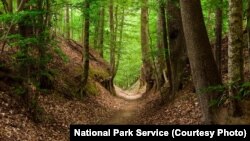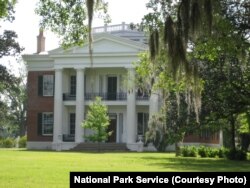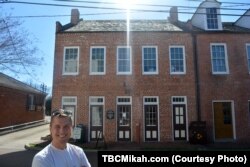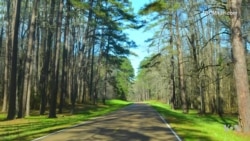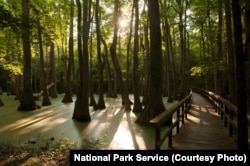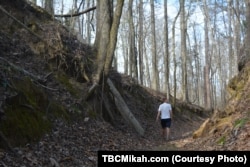In addition to visiting the hallowed battlesite grounds at Vicksburg National Military Park, national parks traveler Mikah Meyer also had the chance to visit several other national park sites in Mississippi, each with its own unique history.
Natchez National Historical Park
Natchez National Historical Park, in the southern part of the state, protects the sites and structures associated with the people of Natchez and its surrounding area -- from its earliest inhabitants through the modern era.
The name is derived from the Natchez American Indians who lived along the Mississippi River at the time of European exploration.
But the area is also known for its pre-Civil War history.
Pre-Civil War South
Mikah, who’s on a mission to visit all of the more than 400 national parks, was able to learn about that history and other aspects of life in the antebellum South through many of the city’s preserved properties.
“It’s a historical park, so it's kind of like the other historical parks in that it's basically the old portion of the town of Natchez and a bunch of various sites,” he explained.
William Johnson House
Among those sites is the home of William Johnson, who was a free black barber.
“It was interesting to learn about his story,” Mikah recounted. “He lived in Natchez before the Civil War as a free black man and had his own house and his own business as a barber.”
According to the National Park Service, Johnson used bricks from buildings destroyed in the infamous tornado of 1840 to construct the State Street estate and commercial business area. The family lived in the upper stories of the house, while the first floor was rented out to merchants. The house allows visitors to learn more about the life of free African Americans in the pre-Civil War South.
After the fall of Vicksburg in 1863, the Union Army occupied the city of Natchez, enforced the Emancipation Proclamation - which freed all slaves in the rebellious states, and put an end to the tragic sale of enslaved people at the Forks of the Road, one of the largest slave markets in the South.
Subsequently, thousands of formerly enslaved men from the Natchez area joined the U.S. Army and Navy.
Driving through history
It would seem unlikely that a modern-looking expressway would be considered a site worth preserving, but that’s exactly what the National Park Service has done with Natchez Trace Parkway. The 715-kilometer roadway once was the main way settlers and travelers reached Natchez from the Tennessee area.
Driving north on that scenic parkway, Mikah said he understood why the Park Service had chosen to preserve it.
“I drove mile zero of that, all the way up to mile 15, just to get a taste of what that was like,” Mikah recounted. “It's what a highway in America would look like if there were no Dairy Queens or gas stations on it. It’s just the road, grass and trees, so it's really pretty -- a really beautiful driving experience.”
While it was cold and wintry up north, the grass along the parkway was a vibrant green. “The trees were starting to bloom, so I can only imagine it in peak spring,” Mikah added.
Alongside much of the parkway is the Natchez Trace National Scenic Trail, a historic forest trail that roughly follows sections of the paved road through the states of Mississippi, Alabama and Tennessee.
Also known as the "Old Natchez Trace," the trail was created and used for centuries by Native Americans, and later, in the late 18th and early 19th centuries, by European and American explorers, traders and emigrants.
Today, visitors like Mikah can still walk those trails and experience the area’s natural beauty.
The "Sunken Trace"
Picturesque land and waterscapes near the trail offer visitors recreational opportunities like hiking, biking, horseback riding and camping.
And Mikah said you can literally see history when you walk the trail, worn down by hundreds of thousands, even millions, of footsteps.
“One of the ways that distinguishes this is there are paths that are very clearly beaten down in that you have essentially a wall on either side of you.”
In the space of a few days, Mikah immersed himself in several fascinating aspects of his country’s history. He says he looks forward to exploring more of it when he visits two more national park sites in the northern part of Mississippi sometime in the near future.
In the meantime, he invites you to learn more about his travels across America by visiting his website, Facebook and Instagram.




